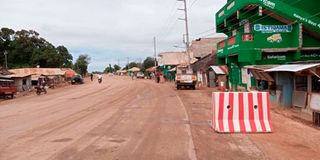
A convoy of buses undergoing security check at Mkunumbi on the Lamu-Witu-Garsen road on December 10, 2019.
| Kalume Kazungu | Nation Media GroupLamu
Premium
Lamu’s ‘highways of death’ mellow into arteries of trade
What you need to know:
- The militants capitalised on the poor state of the roads leading to Lamu, which made it impossible for drivers to speed.
- The attacks saw dozens of civilians and security officers lose their lives at the hands of the militants.
Eight years ago, travelling on the Lamu-Witu-Garsen road was like dancing with death, or walking into a war zone.
On either side of the then badly potholed road were acres upon acres of bushes, which provided perfect cover for Al-Shabaab militants returning to wreak havoc after undergoing military training in war-torn Somalia.
A week would hardly pass without an incident or two being reported of public service vehicles (PSV) or Land Cruisers ferrying security officers exploding into flames after running over an improvised explosive device (IED) buried by the militants at various spots of the then terrible road.
Such explosions would be followed up with a tactical attack by heavily armed militants, who would spray the ambushed vehicles with bullets and finish off anyone who might have survived the IED impact.
The attacks saw dozens of civilians and security officers lose their lives at the hands of the militants, in a reign of terror that peaked between 2014 and 2018.
Milihoi, Mambo Sasa, Nyongoro, Lango la Simba and Gamba were the main hotspots, largely due to the dark thickets that sandwiched roads and were back then crawling with terrorists.
The militants capitalised on the poor state of the roads leading to Lamu, which made it impossible for drivers to speed past a scene of attack.
Besides potholes and bushes, these hotspots were plagued by poor mobile phone networks, which made it impossible for those in distress to seek prompt help or back-up.
But not anymore.
Today, thanks to government efforts to repair the key trade arteries connecting Lamu, Mombasa and Garsen, terror hotspots of 10 years ago have mellowed into havens of peace and centres of booming trade.
Intensified security presence
Mr Swaleh Bunu, a frequent traveller on the Lamu-Witu-Garsen route, acknowledged that great change has been realised on the route.
Stretches where no one would have dared even ride a motorcycle in broad daylight now teem with pedestrians and hawkers selling their wares to vehicles at roadblocks or waiting for other vehicles so as to travel in a convoy for security reasons.
A decade ago, only heavily armed security personnel could be seen patrolling the road, and even among the soldiers there was palpable tension, with heavily shielded eyes darting from one spot to the next in readiness to repulse any attack.
Today, however, with intensified security presence and destruction of al-Shabaab’s hideouts, calm has been restored in the county.
“We no longer fear passing through areas like Milihoi. The security officers in these hotspots are no longer lonely. Things have changed for the better,” said Mr Bunu.
Mr Chengo Karisa, a trader who ferries cosmetics daily on a motorbike from Mpeketoni to Hindi, says security has greatly improved on the road.
Mr Karisa says this has enabled him to operate his business from as early as 5am to as late as 7pm, unlike several years ago, when no one would have dared ride a motorbike on the route even in broad daylight.
“I wake up at 5am daily and sometimes pass through Milihoi at around 5.30am. The place is so secure. Eight years ago, we could not ride motorbikes on the road, especially past Milihoi, for fear of being attacked by al-Shabaab,” said Mr Karisa.
In Nyongoro and Gamba, the Nation found hawkers selling their wares to travellers whose buses and private cars had stopped for security screening.

This picture taken in June 2020 shows a section of the Sh10.8 billion Lamu-Witu-Garsen road.
Police and Kenya Defence Forces (KDF) officers could be seen tightly clutching their guns, with a keen eye on what remains of the bushes around, as their colleagues frisked every passenger, rummaged through every luggage and screened every vehicle for arms and contraband.
“Improved security has afforded us an opportunity to sell food to commuters. Passengers travelling to Mombasa from Lamu and in the reverse direction must stop at these checkpoints. That gives us a chance to sell water, juice, fruits, vegetables and other items,” Ms Maryam Gobu told the Nation in Gamba.
Lamu County Commissioner Irungu Macharia said the completion of the 114km Lamu-Witu-Garsen road has virtually ended terror attacks along the route.
The last insecurity incident was in December 2020, when security agents foiled an attempt by armed militants to attack a Border Patrol Unit (BPU) Land Cruiser. Mr Macharia noted that the government had set up security camps in terror hotspots along the route.
The administrator, however, admitted the camps could not have succeeded in restoring calm in the hotspots had there been no collaboration with the residents, PSV operators and other road users.
“Bushes have been cleared and the road network is good. Members of the public have been reporting threats and positive media coverage has helped in restoring public confidence,” said Mr Macharia.
In December 2014, the national government directed that all public transport vehicles plying the Lamu-Mombasa road had to travel in a convoy under police protection.
This tightened security on the route, so much that in Milihoi, for instance, there has been no terror incident for more than a year.
It is at Milihoi that then Public Works Principal Secretary Mariam El Maawy’s motorcade was attacked by al-Shabaab militants on July 13, 2017.
The PS was taken hostage but a special unit of the KDF rescued her shortly after.
Most notable terror incident
She, however, died in September 2017 at a hospital in South Africa while undergoing treatment.
Today, there are KDF, General Service Unit and regular police camps in Milihoi. The last terror incident in Milihoi occurred in February 2020, when a group of al-Shabaab militants torched an excavator and a lorry belonging to H-Young company, which was engaged in road construction in the area.
In Mambo Sasa near Witu town, the most notable terror incident occurred around 6.30pm on July 19, 2014, when heavily armed militants ambushed a Tahmeed company bus en route to Lamu from Mombasa and sprayed it with bullets.
Seven people – including four police officers – were killed in the attack.
Immediately after the incident, a security roadblock and a KDF camp were established in the area and others in Nyangoro.
Lango la Simba last witnessed an attack in November 2017, when three police officers sustained serious injuries after a convoy of buses they were escorting from Lamu to Mombasa was attacked by heavily armed al-Shabaab terrorists.
The government has been encouraging people to build houses and settle in the areas that were previously shunned due to insecurity.
So changed are these places that residents have lately been pleading with the government to remove roadblocks and police escort vehicles from the road, arguing that heavy security presence creates the false impression that Lamu is still unsafe, which they fear may scare away tourists.
Lamu County Police Commander Moses Murithi, however, said the government has no plans to remove the roadblocks, police escorts or otherwise alter travel the protocols prescribed by the National Security Advisory Committee for the route.
“This is a national issue. We cannot solve it at the county or regional level,” he said.





